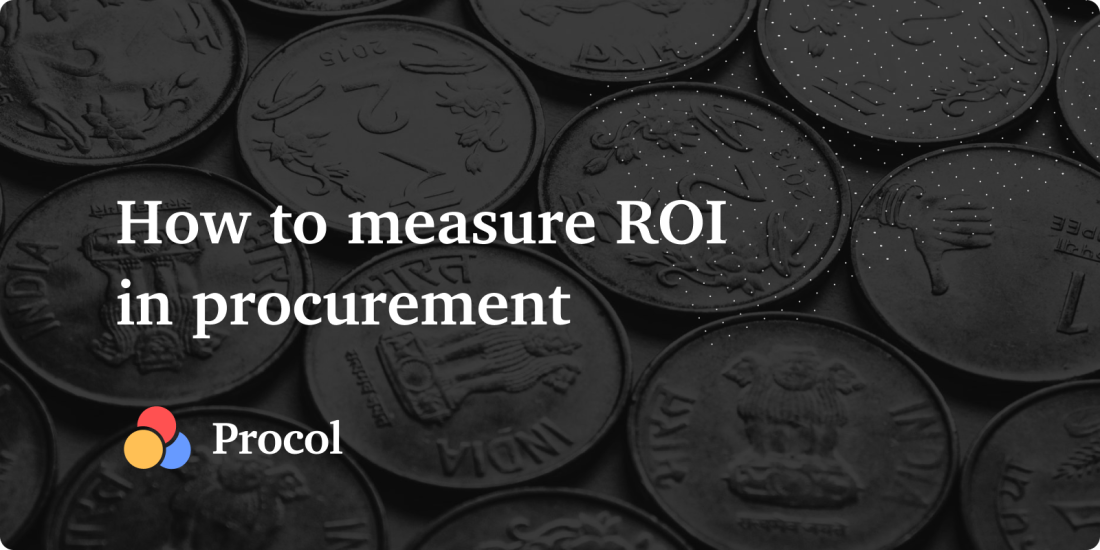How to measure ROI in procurement

TABLE OF CONTENTS
Introduction
Procurement is an integral part of businesses related to manufacturing and production. But, unfortunately, the world is going through a turbulent phase where losses are mounting, and companies get shelved. At this time, it becomes critical for purchase managers to maximize procurement ROI.
Financial uncertainties and market volatility have pushed business leaders to delve deep into their processes and think. Optimizing procurement ROI is one of the basic requirements because it can provide financial stability during uncertain times.
Hence, it is time to shift our focus towards the big question, what are metrics involved in a procurement ROI?
Let us begin.
Procurement ROI Measurement: Efficiency and Effectiveness
“If you cannot measure it, you cannot improve it.” — Lord Kelvin, Irish-born British Engineer.
To measure ROI correctly, you need to look into different avenues of your business operations. For example, in procurement, you measure ROI by putting department costs, vis-à-vis their total savings, both financially and operationally.
Calculating procurement ROI helps purchase managers identify the current situation and jot a roadmap to boost performance levels. In addition, the ROI measurement ensues cost-saving methods and diversion of procurement budgets to other areas related to enhancing bottom-line initiatives.
That brings us to our next question, how to measure procurement ROI?
These are the areas that will require your attention for calculating the return on investment in procurement:
- Your Purchase Order Cycle Time: Total time elapsed from placing the order for goods to its receipt and final payment. If you can shorten the cycle time, you will save procurement costs. Research by American Productivity & Quality Center (APQC) says the top-performing procurement personnel require less time to place a PO and wait fewer days to receive it. Relying on e-procurement can be helpful. Do you believe you can improve your P2P cycle time?
- Your Vendor’s Performance: Measuring the performance of your suppliers is an essential metric in procurement ROI. You must keep an eye on their quality and reliability. Vendor development can improve efficiency, high profits, reduced stock levels, inventory costs, and increased customer satisfaction. Are you checking your vendor’s performance from time to time?
- Your Spend Analysis: It is a critical metric that provides evidence of gaps. It is crucial to understand how efficiently the procurement department is managing the funds. A benchmark figure is a benefit of between 6% and 12% is what the average enterprise sees. For every dollar/euro provided to the management of the procurement department, how much return do you see based on your current allocations?
- Your Cost Savings: This is one of the fundamental metrics that play a critical role in measuring ROI. The Hackett Group finds out that a world-class procurement organization saves 21% in labor costs compared to its peers. Also, using technology opens up the opportunity to reduce process costs by 30%. Don’t you think it is time for a digital transformation?
- Your Team’s Productivity: Automating manual tasks can free up your resources to focus on more strategic business requirements. You can think of it as a cost reduction method. Are you deploying it as of now?
Analyzing these metrics and improving them can help you unlock the maximum procurement ROI and revolutionize your business efficiency and profits.
As a management official in the procurement team, you need to keep a tab on the following steps to measure effectiveness.
- Access to information: Have critical business information at hand to support decision-making activities. Better **finance handling **is the need in industry 4.0. Hire a procurement consultant to have all data in one place in a structured form.
- Digital Transformation: Leverage technology for efficient performance. Being a manager, you should be aware of how procurement SaaS and automation reduce costs. From contract management to strategic sourcing, technology will surely live up to your expectations.
- E-billing: Digital invoices can take away the hassle of putting in manual efforts. Thus, saving time and cost of resource deployment.
- Re-work: There could be some purchase order transactions needing re-work due to some reason. Keep their track in terms of percentage.
- Supplier Leverage: When your organization buys from pre-approved suppliers, they take advantage of the pre-approved discounts and purchase goods and services at reduced costs.
To generate greater ROI in procurement, you should be on top of all these pointers and focus on the improvement areas.
Closing Thoughts
Becoming a world-class procurement organization requires you to standardize and automate routine tasks. In this way, you can achieve greater efficiency while cutting costs. Also, there is an entanglement of sourcing and procurement functions with other enterprise functions through business systems. Therefore, the ripple effect of continuous business improvement in one area should be visible in other areas.
Our next-gen procurement software can save you from the hassles of developing complex auction strategies, contract management, vendor management, and strategic sourcing. Contact us to revolutionize your procurement methods. Click here.
Get a Free Demo
We'd love to hear from you. Please fill out this form to schedule a demo with us. You can also give a call on +91 76666 82222



